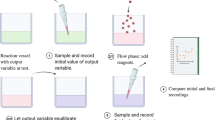Abstract
Stoichiometric network analysis is a systematic, general approach to the qualitative, nonlinear dynamics of chemical reaction mechanisms and other systems with stoichiometry. The advantage of a qualitative approach is that no rate constants are needed to determine qualitative features of the dynamics. If one is interested in stability, the approach yields inequalities among the steady-state concentrations and the rate of flow through sequences of important reactions. These parameters are often the ones most easily measured experimentally. By comparing such experiments with the inequalities derived from stoichiometric network analysis, one can often prove that certain mechanisms cannot account for oscillations or other types of observed dynamics.
The approach covers far more than stability. The existence of steady states of zero concentration has an interesting mathematics and applies to chemical evolution. The folding of the manifold of steady states can be found by direct calculation and plays a role in switching enzymes on and off. The approach leads to theorems showing that some steady states are globally attracting or, possibly, that a region containing chaos or an oscillation is globally attracting. The subject of sensitivity analysis has been reformulated in this context. Algorithms that apply many of the theoretical results to chemical networks have been developed and combined into a computer program package.
Similar content being viewed by others
References
Hill, T. L. (1968),Thermodynamics for Chemists and Biologists, Addison-Wesley, Reading MA.
Clarke, B. L. (1974),J. Chem. Phys. 60, 1481.
Clarke, B. L. (1974),J. Chem. Phys. 60, 1493.
Clarke, B. L. (1975),J. Chem. Phys. 62, 773.
Clarke, B. L. (1980),J. Chem. Phys. 62, 3726.
Clarke, B. L. (1980),Stability of Complex Reaction Networks, inAdvances in Chemical Physics, vol. 43, (Prigogine, I., and Rice, S. A., eds.), John Wiley, New York NY, pp. 1–215.
Clarke, B. L. (1981),J. Chem. Phys. 75, 4970.
Clarke, B. L. (1983), Qualitative Dynamics and Stability of Chemical Reaction Networks inChemical Applications of Topology and Graph Theory. (King, R. B. ed.), Elsevier, Amsterdam, pp. 322–357.
Field, R. J., Körös, E., and Noyes, R. M. (1972),J. Am. Chem. Sci. 94, 8649.
Field, R. J., and Noyes, R. M. (1974),J. Chem. Phys. 60, 1877.
Clarke, B. L. (1974),Faraday Symposium 9, 79.
Clarke, B. L. (1976),J. Chem. Phys. 64, 4165.
Clarke, B. L. (1976),J. Chem. Phys. 64 4179.
Jwo, J. J., and Noyes, R. M. (1975),J. Am. Chem. Soc. 97, 5422.
Varga, M., Gyorgyi, L., and Körös, E. (1985),J. Am. Chem. Soc. 107, 4780.
Clarke, B. L. (1981), inNonlinear Phenomena in Chemical Dynamics (Vidal, C., and Pacault, A. eds.), Springer-Verlag, Berlin, 1981, pp. 240–246.
Clarke, B. L. (1984), inNonequilibrium Dynamics in Chemical Systems, Vidal, C., and Pacault, A., eds.), Springer, New York, p. 218.
Von Hohenbalken, B., Clarke, B. L., and Lewis, J. E. (1987),J. Comp. Appl. Math. 19, 231.
Aguda, B. (1986), Ph.D. Thesis, University of Alberta.
Aguda, B., and Clarke, B. L. (1987),J. Chem. Phys.,87, 3461.
Gantmacher, F. R. (1970),Applications of the Theory of Matrices, Interscience, NY.
Hill, T. L. (1966),J. Theor. Biol. 10, 442.
Clarke, B. L. (1978),SIAM J. Appl. Math. 35, 755.
Clarson, D., Datta, B. N., Johnson, C. R., (1982),SIAM J. Alg. Disc. Meth. 3, 293.
Clarke, B. L., submitted toLinear Algebra and Applications.
Feinberg, M., and Horn, F. J. M. (1974),Chem. Eng. Sci. 29, 775.
Clarke, B. L., and Jeffries, C. (1985),J. Chem. Phys. 82, 3107.
Clarke, B. L., submitted toLinear Algebra and Applications.
Larter, R., and Clarke, B. L. (1985),J. Chem. Phys. 83, 108.
Author information
Authors and Affiliations
Rights and permissions
About this article
Cite this article
Clarke, B.L. Stoichiometric network analysis. Cell Biophysics 12, 237–253 (1988). https://doi.org/10.1007/BF02918360
Received:
Accepted:
Issue Date:
DOI: https://doi.org/10.1007/BF02918360




